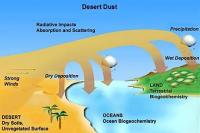- Use environmental data and themes to help your students apply mathematics to real-world problems. Assign environmentally-themed math problems, analyze data such as population figures, land use statistics, and pollutant levels, use data to draw inferences about changes in population and natural resource consumption, and have students explain the impacts of their analysis. Use the search function to the right to explore other ways to use environmental data in your classroom.
- StoryPosted bycgray3onFebruary 1, 2011
The amount of dust in the Earth's atmosphere has doubled over the last century, according to a new study; and the dramatic increase is influencing climate and ecology around the world.
Posted in: - ResourcePosted byAnonymousonMarch 24, 2010
In this lesson, students discover water and energy connections by learning how sources of energy require substantial amounts of water and how energy is used in the process of providing tap water to millions of homes.
Posted in:
Latest in this Subject
View more News, Resources , Professional Development, Grants, Success Stories
- ResourcePosted bycaitlineonJuly 1, 2011
In this lesson plan from National Geographic Xpeditions, students learn the components of a wave, and then discuss the effects of wave height, wavelength and wave period in determining the overall size of a wave. The lesson plan is appropriate for grades 9-12 and adheres to National Geography Standards.
- ResourcePosted bycaitlineonJuly 1, 2011
This curriculum guide from Data in the Classroom contains five activities for grades 6-8 that incorporate real data from NOAA. Students learn how to access and interpret sea surface height and tide data.
View resource - ResourcePosted bycaitlineonJuly 1, 2011
Ocean Planet is an exhibition created by the Smithsonian Institution to share recent ocean research with the public. The exhibit provides an online booklet that includes six lesson plans exploring different aspects of the oceans. The lesson plans may be used to meet content standards science and social studies.
- ResourcePosted bycaitlineonJuly 1, 2011
The Center for Microbial Oceanography has created an ocean acidification lesson plan kit containing two lessons addressing the causes and consequences of ocean acidification. The first lesson contains readings, worksheets, power points and a hands-on experiment. The second lesson contains a more in-depth experiment using electronic probes to simulate the process of ocean acidification.
- ResourcePosted bycaitlineonJuly 1, 2011
This lesson plan from the BRIDGE DATA Series introduces students to the threat that lost of abandoned crab pots pose to marine life, as they continue to catch animals without letting them go. Students analyze data collected from recovered derelict fishing gear and calculate the loss of potential catch that it causes. Materials and related resources for the lesson plan can be downloaded online.
View resource
Do you know of a resource that you think other teachers should know about?
Share your resource!



